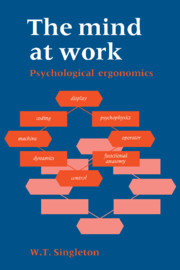5 - INFORMATION PROCESSING
Published online by Cambridge University Press: 22 September 2009
Summary
Concepts
Information acceptance
The processes on the input side of the human operator are, in serial order: sensation, perception and cognition. These are functional terms not neatly separated and not unambiguously related to physiologically identifiable mechanisms. Even the order is complicated by interaction and feedback processes.
Sensation
The sense organs are separately identifiable in that they contain specialised transducers: cells which are particularly reactive to light, pressure, chemicals or temperature. This separation is not the same as the classical five senses in that it merges the auditory system with the somaesthetic system within pressure detectors, and taste and smell within chemical detectors. The somaesthetic system provides experience of pressure discontinuities at the surface and in the movement of the body, it detects movement about joints (the kinaesthetic system), angular and linear acceleration (the vestibular system) and skin pressure (the tactile system) (Fig. 5.1). Its importance is underestimated because, by contrast with the distant senses, it functions with minimal conscious awareness. Taste is not important at work except for specialised tasks related to catering. In addition to its close relationship with taste, smell is useful in fault detection of high temperatures and leaks. Essentially the work of the human operator is guided by three main sensing devices: vision, hearing and somaesthesia. Sensation implies a generalised awareness of changes in light, sound or bodily position and posture. Thus the brain is involved as well as the specialised sense organs.
- Type
- Chapter
- Information
- The Mind at Work , pp. 194 - 259Publisher: Cambridge University PressPrint publication year: 1989

